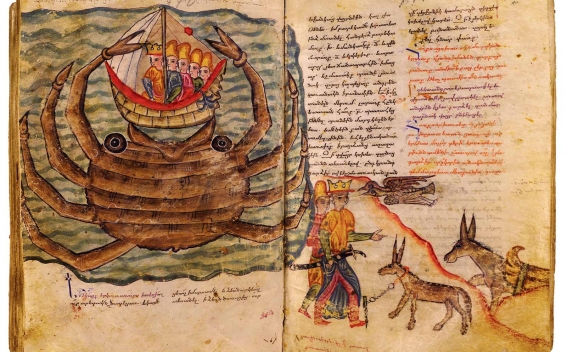The Prophets, Angels, & Churches of 'Armenia!'- The New York Review

One small display in an exhibition can grab you by the collar. In the case of “Armenia!” at the Metropolitan Museum, it was the image of a spherical wide-eyed crab in a ridged armor swallowing Alexander the Great, along with his ship and retinue, set against a wavy sea that might have been drawn by a child. It is attributed to Zak‘ariay of Gnunik and appears in an illuminated manuscript of the Alexander Romance (1538–1544), the legends surrounding the exploits of Alexander the Great, much loved by Muslims, Orthodox Christians, and Armenians alike. Dr. Helen Evans, the Met’s curator of Byzantine Art, told me, “That crab is too good not to be recognized as the type of art we don’t expect from East Christians.” And it most definitely wasn’t, she added, “the stiff art of the Byzantines that Vasari disapproved of.” Giorgio Vasari, the Italian architect, painter, and historian, author of Lives of the Most Eminent Painters, Sculptors and Architects (1550) Western culture’s first art historian, who coined the use of the term “Renaissance,” unfairly saw in Byzantine abstractions, coming after Greek and Roman art, a decline in skills rather than an artistic choice, the New York Review reports.
The exhibition opened with the Primate of the Eastern Diocese of the Armenian Church of America blessing the occasion by singing, with two others, an allelujah in a voice that filled the galleries with the sound of Armenian liturgical chants. There are one hundred and forty objects in the show, including jewelry and reliquaries, as well as church models, illustrated manuscripts, and textiles for liturgical use—one fourteen-foot-long red and gold “omophorion” of interwoven square crosses is reminiscent of the Russian avant-garde artist Kazimir Malevich’s crosses on canvas and icons on paper. The objects on display range from the fourth to the seventeenth centuries and represent the different regions Armenians inhabited, from their homeland at the base of Mount Ararat, to the kingdom of Cilicia, and further East to New Julfa, in Iran. Armenia was one of the first states to adopt the Christian religion—as early as AD 301—and its history has been defined both by this, its status as an outpost of Eastern Orthodox religion surrounded by Muslim neighbors, and by its role in establishing trade routes from China and India to Western Europe, and from Egypt and the Holy Land to Russia.
The exclamation mark following the word “Armenia” in the exhibition’s title—Evans’s idea—was meant to convey her surprise that Armenian art and culture aren’t studied more or better known. A champion of what she calls “this edge of Byzantium that is Armenian art and culture,” Evans has been wanting to assemble a show such as this one ever since she began researching her dissertation on Armenian manuscripts of the kingdom of Cilicia almost forty years ago. (She has also curated other Byzantine blockbusters at the Met: “The Glory of Byzantium” (1997), “Byzantium: Faith and Power” (2004), and “Byzantium and Islam” (2012).)
-
 17:08
17:08The regular session of the Anti-corruption Policy Council takes place in Jermuk
-
 15:05
15:05The Prime Minister sends congratulatory messages to the supreme leader of Iran and the President of Iran
-
 11:11
11:11Armenia sends earthquake aid to Turkey
-
 10:43
10:43Commemoration of the Pontiff St. Sahak Partev
-
 09:16
09:16Some roads are closed and difficult to pass in Armenia
-
 19:55
19:55Phone conversation of the Foreign Minister of Armenia with the U.S. Assistant Secretary of State for European and Eurasian Affairs
-
 18:30
18:30Prime Minister Pashinyan and President Khachaturyan meet
-
 18:20
18:20Ararat Mirzoyan with Co-Chairman of the OSCE Minsk Group of France Brice Roquefeuil
-
 17:01
17:01Humans could land on Mars within 10 years, Musk predicts
-
 16:45
16:45France, US urge 'immediate' end to Nagorno Karabakh blockade
-
 16:01
16:01Blockaded Nagorno Karabakh launches fundraiser to support quake-hit Syria
-
 15:59
15:59Earthquake death toll in Turkey rises to 18,342
-
 15:43
15:43Ararat Mirzoyan Held a Telephone Conversation with Sergey Lavrov
-
 15:06
15:06French president rules out fighter jet supplies to Ukraine in near future
-
 14:47
14:475 Day Weather Forecast in Armenia
-
 14:44
14:44President Vahagn Khachaturyan wrote a note in the book of condolences opened in the Embassy of Syria in Armenia
-
 14:20
14:20Azerbaijan’s provocations impede establishment of peace and stability – Armenian FM tells Russian Co-Chair of OSCE MG
-
 12:57
12:57France representation to OSCE: Paris calls on Azerbaijan to restore freedom of movement through Lachin corridor
-
 11:40
11:40Command of Kosovo forces highly appreciated preparation of Armenian peacekeepers
-
 10:16
10:16The United States withdrew from sanctions against Syria for six months the provision of assistance after the earthquake
day
week
month
Humidity: %
Wind: km/h









